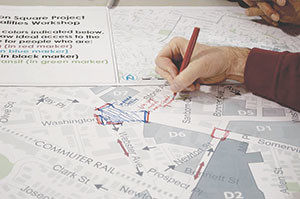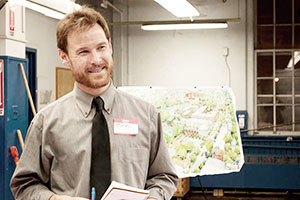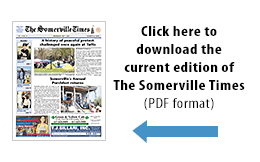
Infrastructure, brownfield and transportation were the main topics of discussion at last week’s Somerville By Design: Union Square workshop.
The third Somerville by Design workshop brought Union Square’s master developer, US2 to discuss three key factors that affect the redevelopment of the neighborhood with the public: infrastructure, brownfield and transportation. The public workshop was held last week at the Old Post Office Building in Union Square.
US2, aka Union Square Station Associates, is a development team that comes up with strategic plans for the Union Square Redevelopment Project. Last June, Somerville Redevelopment Authority unanimously voted US2 to handle the one billion-dollar project.
US2 also hired a community transportation planning company, Nelson Nygaard, and a city infrastructure consulting firm, Stantec, to collaborate on the redevelopment of Union Square.
Greg Karczewski, president of US2, said, “The infrastructure and transportation are fundamental to our ability as a group to really create what’s the vision for Union Square.”

Those attending the Somerville By Design: Union Square workshop were brought up-to-date on the latest plans and proposals for development of the area. ~Photos by Douglas Yu
Frank Holmes, Principal of Stantec, presented the issues that are associated with storm water. He said that two thirds of the storm water in Somerville was drained through Union Square, and the draining process largely relied on limited pipes and pumping systems with finite capacity.
Holmes explained that the city is planning to expand the capacity of the pumping system in Somerville, so the storm water can be stored underground instead of being let go onto the streets.
Other possible solutions include planting on rooftops to absorb certain amounts of storm water to reduce the chance of flooding, according to the meeting.
Elias A. Rashmawi touched upon the brownfield-related issues of Union Square. A brownfield is a property for which the expansion, redevelopment, or reuse of may be complicated by the presence or potential presence of a hazardous substance, pollutant, or contaminant, according to U.S. Environmental Protection Agency.
“It [researching on brownfield] clearly identifies commercial and industrial activities, as well as residential to optimize the redevelopment,” Rashmawi said.
In order to come up with a plan regarding how to properly use the property, Stantec will first draft a profile of a certain property. The profile includes how much clean up that has been done in the past and how much pollutant that is left to be cleaned. After a thorough assessment of the property through its profile, Stantec needs to make sure the reuse of the property benefits the public health and environment.
When it comes to community transportation planning, Ralph J. De Nisco, Principal of Nelson Nygaard, said, “Transportation is changing nationally. There is a whole new series of sharing economy. That’s just the way people think of access to mobility. Somerville is changing as well,” Nisco said.
Parking and traffic numbers will drastically change after the Green Line Extension project is complete. Nisco mentioned they were still in the process of obtaining more information about parking.
“Twenty-five percent of the Union Square residents take transits to get to their jobs today before the Green Line comes in. Compare that to people, who work in Union Square, people who come from somewhere else to work here, is a lot higher,” Nisco said.
Nisco also compared ADT (average daily traffic) numbers on different roads of Union Square, traffic numbers based on various timetables. He said, “We did a parking inventory of Union Square. We went out, and counted all the spaces, on street and off-street, public and private, that exist today.”
Future transportation redevelopment plan to Union Square will be made based on the updated data of parking and traffic numbers, according to the meeting.
The participants were handed out with maps at each table to provide more public advice on the Union Square redevelopment after the presentations. In the mean time, the city is still looking for public input through social media.












Reader Comments